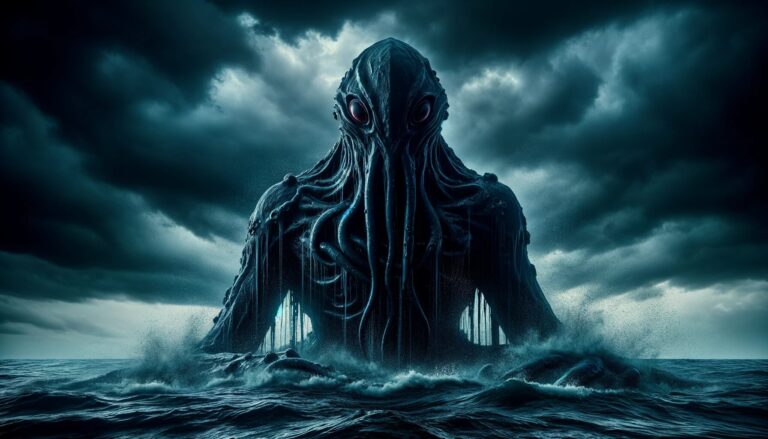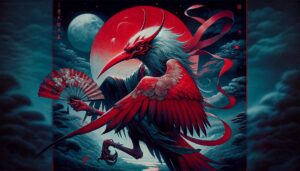Table of Contents
In the dark depths of Japanese mythology, there exists a creature shrouded in mystery and terror: the Umibozu. This fearsome sea monster has haunted the imaginations of sailors and storytellers for centuries, leaving an indelible mark on Japanese folklore.
Origins
The murky origins of the Umibozu parallel the depths of the sea it inhabits. Additionally, “Umi Monogatari” (海物語), a collection of tales from the 17th century, offers one of the earliest references to this mythical sea monster. According to these stories, the Umibozu assumed the role of a vengeful spirit or demon, dwelling beneath the waves and emerging to wreak havoc on unsuspecting sailors and their vessels.
The term “Umibozu” itself, when translated, reveals intriguing connections to religious imagery. In Japanese, it translates to “sea monk” or “sea priest,” hinting at a peculiar association between this creature and spiritual connotations. Some scholars even postulate that the concept of the Umibozu might have arisen from genuine encounters with colossal squids or other enigmatic sea creatures in ancient times, creatures that were often ascribed supernatural attributes.
Family Ties and Associations
In Japanese folklore, the Umibozu typically appears as a solitary entity, rendering it difficult to establish familial connections. Nonetheless, certain accounts hint at the existence of “Umibozu families” or “Umibozu clans,” implying potential variations of this sea monster across different Japanese regions.
Furthermore, the Umibozu shares associations with other maritime creatures and spirits, including the Umijirushi (sea imprints) and the Umisachihiko (sea-deity prince). These associations serve to underscore its profound bonds with the sea and the supernatural realm. Collectively, these connections hint at a complex network of mythological beings that inhabit Japan’s coastal regions.
Appearance

The appearance of the Umibozu is a subject of much speculation and variation within Japanese folklore. Accounts describing this creature’s physical form are inconsistent, adding to its mystique and elusiveness.
One prevalent depiction of the Umibozu presents it as a colossal, black, shadowy figure with a humanoid shape. Moreover, its body boasts a slimy, inky skin that glistens ominously with a dark, eerie sheen. Its eyes, in particular, are frequently described as piercing red orbs that emit a malevolent glow, further intensifying the terror it inspires. This nightmarish visage can be aptly compared to the embodiment of the tempestuous seas themselves—an unrelenting force of nature, taking on a sinister form.
Other accounts, however, suggest that the Umibozu can shape-shift and appear as a giant octopus or squid, making it even more adaptable and unpredictable in its attacks on unsuspecting sailors. This ability to change form further fuels the fear and uncertainty associated with encounters with the Umibozu.
Abilities
The Umibozu is not merely a passive sea creature; it possesses a range of supernatural abilities that make it a formidable force to be reckoned with. Some of its most notable powers include:
- Control Over the Sea: Believed to possess the power to manipulate the sea itself, the Umibozu can conjure colossal waves and turbulent storms. In its malevolent fury, it capsizes ships and drowns sailors, a manifestation of its vengeful nature.
- Shape-Shifting: As mentioned earlier, the Umibozu can change its form, morphing into various marine creatures, including giant squids and octopuses. This shapeshifting ability allows it to approach its prey stealthily and strike without warning.
- Invisibility: In some accounts, the Umibozu can render itself invisible, making it even more difficult to detect and evade. This supernatural camouflage adds an element of surprise to its attacks, leaving sailors defenseless in the face of impending doom.
- Voice Manipulation: The Umibozu is known to mimic human voices, luring sailors closer with the cries of loved ones or fellow crew members. This deceptive tactic amplifies the sense of dread and confusion during encounters with the creature.
- Drain Vital Energy: In certain legends, it is believed that the Umibozu can drain the life force or vitality from its victims, leaving them weakened and vulnerable. This chilling ability contributes to the fear and superstition surrounding this mythical sea monster.
Symbols
While the Umibozu may not have a well-defined set of symbols like some other mythical creatures, its associations with the sea and the unknown have inspired various representations in art and literature. Here are some symbols commonly associated with the Umibozu:
- Stormy Seas: Rough and turbulent seas, often depicted with towering waves and dark clouds, symbolize the Umibozu’s destructive nature and its ability to incite chaos on the water.
- Red Eyes: The creature’s piercing red eyes are a symbol of its malevolence and otherworldly nature. They are often used to evoke a sense of dread and foreboding in depictions of the Umibozu.
- Ink and Darkness: The Umibozu’s inky black skin and its association with the depths of the ocean represent the unknown and the fear of what lies beneath the surface.
- Shapeshifting: The ability to change form symbolizes the Umibozu’s adaptability and its capacity to take on different guises, adding an element of unpredictability to its character.
Related Myths and Stories

The Umibozu features prominently in numerous Japanese folktales and legends, each adding layers to its mysterious persona. Here are a few notable stories and myths involving this enigmatic sea monster:
The Umibozu of Shimane
In the heart of Shimane Prefecture, a legendary tale unfolds—the story of a resolute fisherman who dared to challenge the dreaded Umibozu haunting their coastal waters. With unwavering courage and remarkable resourcefulness, he embarked on a perilous mission to rid his village of this malevolent sea creature.
As the Umibozu’s dark presence cast a shadow over the community, the fisherman devised a cunning plan. He meticulously studied the Umibozu’s patterns, waiting for the opportune moment to strike. When the creature emerged from the depths of the sea, he pounced into action.
Employing his wits and fearlessness, the fisherman engaged the Umibozu in a battle of wits and strength. Moreover, he cleverly outmaneuvered the creature, leveraging his knowledge of the sea to gain the upper hand. With each strategic move, he chipped away at the Umibozu’s power, gradually diminishing its menacing presence.
In the end, the brave fisherman’s indomitable spirit prevailed. He forced the Umibozu to retreat, saving his fellow villagers from its vengeful wrath. This captivating legend serves as a testament to the enduring themes of courage and resourcefulness when confronted with supernatural threats, inspiring generations with the tale of a humble hero who triumphed over the enigmatic terror of the sea.
The Umibozu’s Bargain
In another intriguing tale, a desperate sailor found himself ensnared by the clutches of an Umibozu. Faced with impending doom, he devised a daring plan. Promising to return with a barrel of sake, he struck a bargain with the creature, pleading for his life.
With unwavering determination, the sailor ventured ashore, racing against time and treacherous tides to fulfill his promise. Moreover, he skillfully navigated through the rugged terrain, procured the coveted barrel of sake, and returned to the haunting sea creature.
As he presented the sake to the Umibozu, a peculiar transformation overcame the creature. Remarkably, its demeanor shifted from malevolent to capricious, unveiling its unpredictable nature. Furthermore, in a surprising twist of fate, the Umibozu spared the sailor’s life, allowing him to depart unharmed.
This enigmatic encounter between the desperate sailor and the Umibozu underscores the whimsical and capricious tendencies of the sea monster. Consequently, it serves as a testament to the unpredictable and mysterious nature of the creatures inhabiting the ocean’s depths, where even the direst situations may take unexpected turns.
The Lost Ship

In a haunting tale, a ship ventured recklessly close to the Umibozu’s domain. Suddenly, without warning, the malevolent creature unleashed its supernatural power, summoning a ferocious storm that engulfed the vessel. As a result, waves rose like towering giants, and the tempest raged with unrestrained fury.
Crew members, their faces etched with fear, fought desperately against the merciless elements. But the Umibozu’s wrath was unrelenting. Lightning split the sky, thunder echoed like a wrathful deity, and rain fell in torrents as if the heavens wept for the ill-fated souls aboard.
Despite their valiant efforts, the ship and its crew succumbed to the relentless fury of the sea. The vessel was torn asunder, its splintered remnants disappearing beneath the unforgiving waves. Tragically, not a single soul survived the cataclysmic tempest.
This chilling tale serves as a stark cautionary reminder of the perils that await those who dare to defy the natural order and venture into the realm of the supernatural. Furthermore, it underscores the ancient belief that the sea, like the Umibozu itself, holds powers beyond human comprehension. Consequently, such defiance can have dire consequences.
The Umibozu’s Lullaby
In the realms of maritime folklore, a peculiar narrative unfolds: the Umibozu’s Lullaby. Moreover, in some tales, the Umibozu takes on a persona that starkly contrasts its fearsome reputation—a lonely, melancholic creature singing a haunting, mournful lullaby under the cover of night.
As the darkness blankets the sea, the forlorn melody emanates from the depths, creating a mesmerizing and eerie song that transcends mortal understanding. Furthermore, its ethereal beauty beckons, echoing across the desolate waters. Consequently, sailors who chance upon this haunting lullaby find themselves spellbound by its enchanting notes, unable to resist its alluring call.
Drawn by the siren-like song, these unfortunate seafarers navigate their vessels closer to the source of the melody, unaware of the peril that awaits. The Umibozu’s ability to manipulate and ensnare its victims becomes evident as it lures them further into its grasp.
Yet, as the sailors draw near, the true nature of the Umibozu reveals itself. With a sudden, malevolent transformation, it emerges from the depths, shrouded in darkness, and seizes its prey. The once-beautiful lullaby transforms into a nightmarish crescendo, marking the sailors’ inexorable descent into doom.
This eerie tale serves as a stark reminder of the deceptive nature of the Umibozu. Moreover, it highlights the treacherous allure of the sea’s mysteries, where beauty can mask danger, and enchantment can lead to despair.
FAQ
What does "Umibozu" mean?
The word "Umibozu" translates to "sea monk" or "sea priest" in Japanese, hinting at its eerie connection to religious imagery
How is the Umibozu described?
It is often depicted as a colossal, black, shadowy figure with red eyes, covered in slimy, inky skin. It can also shapeshift into various forms, adding to its mystique.
What powers does the Umibozu possess?
The Umibozu is said to control the sea, conjuring storms and waves. It can mimic human voices, luring sailors to their doom. Some tales suggest it can drain the life force of its victims.
Are there stories about encounters with the Umibozu?
Yes, there are various legends about sailors encountering the Umibozu, with outcomes ranging from tragic to surprising.
What does the Umibozu symbolize?
It symbolizes the mysterious and unpredictable nature of the sea, as well as the dangers that lurk beneath its surface in Japanese folklore.




